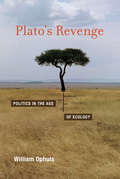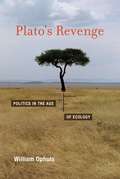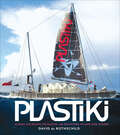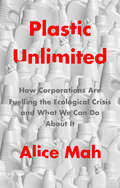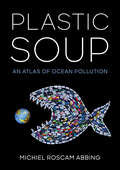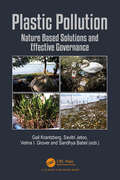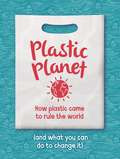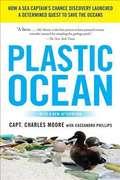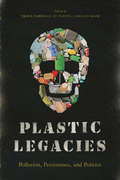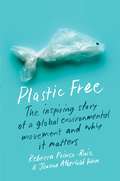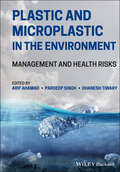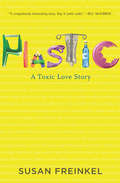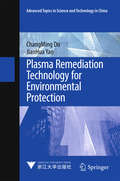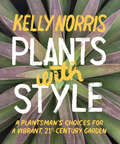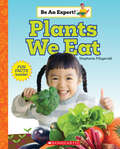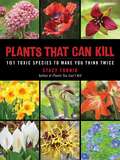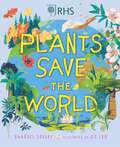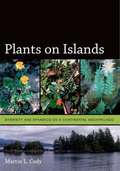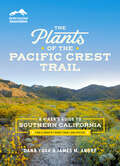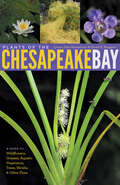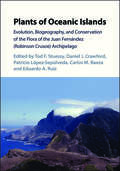- Table View
- List View
Plato's Revenge: Politics in the Age of Ecology
by William OphulsA provocative essay that imagines a truly ecological future based on political transformation rather than the superficialities of “sustainability.” In this provocative call for a new ecological politics, William Ophuls starts from a radical premise: “sustainability” is impossible. We are on an industrial Titanic, fueled by rapidly depleting stocks of fossil hydrocarbons. Making the deck chairs from recyclable materials and feeding the boilers with biofuels is futile. In the end, the ship is doomed by the laws of thermodynamics and by the implacable biological and geological limits that are already beginning to pinch. Ophuls warns us that we are headed for a postindustrial future that, however technologically sophisticated, will resemble the preindustrial past in many important respects. With Plato's Revenge, Ophuls, author of Ecology and the Politics of Scarcity, envisions political and social transformations that will lead to a new natural-law politics based on the realities of ecology, physics, and psychology.In a discussion that ranges widely—from ecology to quantum physics to Jungian psychology to Eastern religion to Western political philosophy—Ophuls argues for an essentially Platonic politics of consciousness dedicated to inner cultivation rather than outward expansion and the pursuit of perpetual growth. We would then achieve a way of life that is materially and institutionally simple but culturally and spiritually rich, one in which humanity flourishes in harmony with nature.
Plato's Revenge
by William OphulsIn this provocative call for a new ecological politics, William Ophuls starts from a radical premise: "sustainability" is impossible. We are on an industrial Titanic, fueled by rapidly depleting stocks of fossil hydrocarbons. Making the deck chairs from recyclable materials and feeding the boilers with biofuels is futile. In the end, the ship is doomed by the laws of thermodynamics and by the implacable biological and geological limits that are already beginning to pinch. Ophuls warns us that we are headed for a postindustrial future that, however technologically sophisticated, will resemble the preindustrial past in many important respects. With Plato's Revenge, Ophuls, author of Ecology and the Politics of Scarcity, envisions political and social transformations that will lead to a new natural-law politics based on the realities of ecology, physics, and psychology. Conventional environmental politics tries to treat the most glaring symptoms of ecological illness while ignoring the anti-ecological dynamic that created them. Ophuls returns to first principles, relying on time-tested classical authors--Plato, Rousseau, Jefferson, Thoreau, and others who have grappled with the fundamental issues of politics. He invites readers to question their most basic social, economic, political, and even moral assumptions, as the first step toward imagining a truly ecological future. In a discussion that ranges widely--from ecology to quantum physics to Jungian psychology to Eastern religion to Western political philosophy--Ophuls argues for an essentially Platonic politics of consciousness dedicated to inner cultivation rather than outward expansion and the pursuit of perpetual growth. We would then achieve a way of life that is materially and institutionally simple but culturally and spiritually rich, one in which humanity flourishes in harmony with nature.
Plastiki
by David De RothschildExplorer, global green leader, and eco-TV host David de Rothschild recounts the extraordinary journey of the Plastiki, an innovative and mostly untested sixty-foot catamaran that floats on 12,500 reclaimed plastic bottles. It was a voyage that took de Rothschild and a five-person crew 10,000 miles from the U.S. to Australia, sailing through rarely traveled, dangerous waters, risking their lives to call attention to our fragile oceans. Their exploration included urgent study of ocean pollution, island nations threatened by rising seas, damaged coral reefs, and the acidifying ocean itselfand their discoveries are a call to action. Packed with exciting narrative, images, maps, journal entries, plans, and sketches, this is the only firsthand account of what may be the most important adventure of our time.
Plastic Unlimited: How Corporations Are Fuelling the Ecological Crisis and What We Can Do About It
by Alice MahDespite the global movement to tackle plastic pollution, demand for plastics continues to rise. As the world transitions away from fossil fuels, plastics are set to be the biggest driver of oil demand. Single-use plastics – deemed essential in the fight against COVID-19 – have been given a new lease of life. In a world beset with crisis fatigue, what can we do to curb the escalating plastics crisis? In this book, Alice Mah reveals how petrochemical and plastics corporations have fought relentlessly to protect and expand plastics markets in the face of existential threats to business. From denying the toxic health effects of plastics to co-opting circular economy solutions to plastic waste and exploiting the opportunities offered up by the global pandemic, industry has deflected attention from the key problem: plastics production. The consequences of unfettered plastics growth are pernicious and highly unequal. We all have a part to play in reducing plastics consumption but we must tackle the problem at its root: the capitalist imperative for limitless growth.
Plastic Soup: An Atlas of Ocean Pollution
by Michiel Roscam AbbingPlastics have transformed every aspect of our lives. Yet the very properties that make them attractive—they are cheap to make, light, and durable—spell disaster when trash makes its way into the environment. Plastic Soup: An Atlas of Ocean Pollution is a beautifully-illustrated survey of the plastics clogging our seas, their impacts on wildlife and people around the world, and inspirational initiatives designed to tackle the problem. In Plastic Soup, Michiel Roscam Abbing of the Plastic Soup Foundation reveals the scope of the issue: plastic trash now lurks on every corner of the planet. With striking photography and graphics, Plastic Soup brings this challenge to brilliant life for readers. Yet it also sends a message of hope; although the scale of the problem is massive, so is the dedication of activists working to check it. Plastic Soup highlights a diverse array of projects to curb plastic waste and raise awareness, from plastic-free grocery stores to innovative laws and art installations. According to some estimates, if we continue on our current path, the oceans will contain more plastic than fish by the year 2050. Created to inform and inspire readers, Plastic Soup is a critical tool in the fight to reverse this trend.
Plastic Pollution: Nature Based Solutions and Effective Governance (Water)
by Gail Krantzberg Savitri Jetoo Velma I. Grover Sandhya BabelPlastics show up in every area of our lives. They are durable, cheap and light, properties that make them attractive but also problematic for the environment. The focus of this book is not just to highlight the problem of plastics, its definition, and how plastic pollution is impacting human health and environment but also to look at some best practices in both nature based solutions and in the field of law and policies. The first section of the book focuses on plastic pollution – it’s origin, relationship to climate change, linear/circular economy, followed by sustainable plastics, scientific solutions, and how policies can address plastic pollution. This includes looking at better designs, more sustainable feedstocks, and partnerships between various stakeholders worldwide including USA, China, Canada, South Korea, Thailand. This book will interest those who are associated with the production industry, packaging industry, and waste management industry as well as, academicians, students and policymakers.
Plastic Planet: How Plastic Came to Rule the World (and What You Can Do to Change It)
by Georgia Amson-BradshawPlastic Planet offers young readers the perfect, non-alarmist introduction to Earth's plastic crisisPlastic pollution is now found in every environment on Earth, from the deepest oceans to the driest deserts and the most remote ice sheets.Plastic Planet offers readers aged 8 and up a look at plastic through the ages, exploring what it is, how it's made and how we have become so dependent on it in a single-use, disposable world. It highlights the social inequality of plastic pollution and explores how plastic has become a widespread and dangerous pollutant that is inextricably linked to climate change. The book looks ahead to possible solutions to our plastic crisis, from global changes such as changing people's mindsets, to innovations such as compostable plastics, to practical solutions such as recycling and bottle return schemes.
Plastic Ocean
by Capt. Charles MooreA prominent seafaring environmentalist and researcher shares his shocking discovery of the Great Pacific Garbage Patch, and inspires a fundamental rethinking of the Plastic Age. In the summer of 1997, Charles Moore set sail from Honolulu returning home after competing in a trans-Pacific race. To get to California, he and his crew took a shortcut through the seldom-traversed North Pacific Subtropical Gyre, a vast "oceanic desert" where winds are slack and sailing ships languish. There, Moore realized his catamaran was surrounded by a "plastic soup." He had stumbled upon the largest garbage dump on the planet--a spiral nebula where plastic outweighed zooplankton, the ocean's food base, by a factor of six to one. In Plastic Ocean, Moore recounts his ominous findings and unveils the secret life and hidden proper ties of plastics. From milk jugs to polymer molecules small enough to penetrate human skin or be unknowingly inhaled, plastic is now suspected of contributing to a host of ailments, including infertility, autism, thyroid dysfunction, and some cancers. An urgent call to action, Moore's sobering revelations will be embraced by activists, concerned parents, and anyone concerned about the deadly impact and implications of this man-made blight.
Plastic Legacies: Pollution, Persistence, and Politics
by Trisia Farrelly Sy Taffel Ian ShawThere is virtually nowhere on earth that remains untouched by plastics and the situation presents a serious threat to our natural world. Despite the magnitude of the problem, the interventions most often put in place are consumer-led and market-based and only nominally capable of addressing the issue. As the problem worsens and neoliberal ideologies limit the world’s responses to this crisis, there is a growing need for legislative frameworks that attend to the complex social and ecological issues associated with plastics. The contributors to this volume bring expertise from across academic disciplines to illustrate how plastics are produced, consumed, and discarded and to find holistic and integrated approaches that demonstrate an understanding of the wide-ranging problem. From the plasticization of earth’s oceans to the endocrine disrupting chemicals that have the potential to seriously harm life as we know it, these essays beg the question that we all must answer: what is our plastic legacy? With contributions by: Imogen E. Napper, Sabine Pahl, Richard C. Thompson, Sasha Adkins, Stephanie B. Borrelle, Jennifer Provencher, Tina Ngata, Sven Bergmann, Christina Gerhardt, Elyse Stanes, Tridibesh Dey, Mike Michael, Laura McLauchlan, Johanne Tarpgaard, Deirdre McKay, Padmapani Perez, Lei Xiaoyu, and John Holland.
Plastic Free: The Inspiring Story of a Global Environmental Movement and Why It Matters
by Rebecca Prince-Ruiz Joanna Atherfold FinnIn July 2011, Rebecca Prince-Ruiz challenged herself to go plastic free for the whole month. Starting with a small group of people in the city of Perth, the Plastic Free July movement has grown into a 250-million strong community across 177 countries, empowering people to reduce single-use plastic consumption and create a cleaner future.This book explores how one of the world’s leading environmental campaigns took off and shares lessons from its success. From narrating marine-debris research expeditions to tracking what actually happens to our waste to sharing insights from behavioral research, it speaks to the massive scale of the plastic waste problem and how we can tackle it together. Interweaving interviews from participants, activists, and experts, Plastic Free tells the inspiring story of how ordinary people have created change in their homes, communities, workplaces, schools, businesses, and beyond.It is easy to feel overwhelmed in the face of global environmental problems and wonder what difference our own actions could possibly make. Plastic Free offers hope for the future through the stories of those who have taken on what looked like an insurmountable challenge and succeeded in innovative and practical ways, one step—and one piece of plastic—at a time.
Plastic and Microplastic in the Environment: Management and Health Risks
by Arif Ahamad Pardeep Singh Dhanesh TiwaryORGANIC REACTIONS Thought-provoking discussions of the challenges posed by—and potential solutions to—plastic and microplastic pollution In Plastic and Microplastic in the Environment: Management and Health Risks, a team of distinguished environmental researchers delivers an up-to-date exploration of plastic and microplastic environmental contamination, conventional and advanced plastics management techniques, and the policies adopted across the globe to combat the phenomenon of plastics contamination. Containing a balanced focus on both conventional plastics and microplastics, this book discusses the potential health issues related to plastic and microplastic infiltration in a variety of global environments and environmental media, including freshwater environments, oceanic environments, soil and sediment, and air. Insightful treatments of commercial and social issues, including the roles of corporate social responsibility initiatives and general education in the fight against plastic and microplastic pollution, are provided as well. Plastic and Microplastic in the Environment also includes: A thorough introduction to plastic debris in global environments, including its accumulation and disintegration Comprehensive explorations of policies for strengthening recyclable markets around the world Practical discussions of the prevalence of microplastics in the marine environment, air, soil, and other environmental media In-depth examinations of wastewater treatment plants as a potential source point of microplastics, as well as conventional and advanced microplastic particle removal technologies Perfect for academics, postgraduates and advanced undergraduates in fields related to environmental science and plastics, Plastic and Microplastic in the Environment: Management and Health Risks will also earn a place in the libraries of professionals working in the plastics industries and environmental policymakers.
Plastic: A Toxic Love Story
by Susan Freinkel&“This eloquent, elegant book thoughtfully plumbs the . . . consequences of our dependence on plastics&” (The Boston Globe, A Best Nonfiction Book of 2011). From pacemakers to disposable bags, plastic built the modern world. But a century into our love affair, we&’re starting to realize it&’s not such a healthy relationship. As journalist Susan Freinkel points out in this eye-opening book, we&’re at a crisis point. Plastics draw on dwindling fossil fuels, leach harmful chemicals, litter landscapes, and destroy marine life. We&’re drowning in the stuff, and we need to start making some hard choices. Freinkel tells her story through eight familiar plastic objects: a comb, a chair, a Frisbee, an IV bag, a disposable lighter, a grocery bag, a soda bottle, and a credit card. With a blend of lively anecdotes and analysis, she sifts through scientific studies and economic data, reporting from China and across the United States to assess the real impact of plastic on our lives. Her conclusion is severe, but not without hope. Plastic points the way toward a new creative partnership with the material we love, hate, and can&’t seem to live without. &“When you write about something so ubiquitous as plastic, you must be prepared to write in several modes, and Freinkel rises to this task. . . . She manages to render the most dull chemical reaction into vigorous, breathless sentences.&” —SF Gate &“Freinkel&’s smart, well-written analysis of this love-hate relationship is likely to make plastic lovers take pause, plastic haters reluctantly realize its value, and all of us understand the importance of individual action, political will, and technological innovation in weaning us off our addiction to synthetics.&” —Publishers Weekly &“A compulsively interesting story. Buy it (with cash).&” —Bill McKibben, author of The End of Nature &“What a great read—rigorous, smart, inspiring, and as seductive as plastic itself.&” —Karim Rashid, designer
Plasma Remediation Technology for Environmental Protection
by Changming Du Jianhua YanThis book introduces a new technology for environmental protection, namely plasma cleaning. It brings together technological advances and research on plasma generators and their application in environmental science and engineering, including contaminated soil remediation, waste water degradation, metal recovery from waste solution, sterilization and polluted air remediation. It provides a balanced and comprehensive discussion of the core principles, novel plasma reactors and diagnostics, and state-of-the-art environmental applications of plasma. As such, it represents a valuable reference guide for scientists, engineers and graduate students in the fields of environmental science and plasma physics.
Plants with Style: A Plantsman's Choices for a Vibrant, 21st-Century Garden
by Kelly Norris“A love letter to plants…that oozes enthusiasm.” —The English Garden Why settle for lackluster gardens filled with dull, ho-hum plants? In this spirited, provocative book, plant guru Kelly Norris calls for a garden revolution: out with the boring plants and in with the exciting newcomers that will make your jaw drop and your pulse quicken! A passionate horticulturist and lifelong gardener, Kelly is the ideal guide to the botanical riches available to today’s gardeners. In chapters on environment, structure, seasonal standouts, and plant combinations he shines a spotlight on the A-list plants in every category—plants that will thrive, not merely survive. Along the way, he shows you how to forge a personal style in harmony with your garden’s setting and local environment. As Kelly puts it, “A garden is the best way to savor life on earth.” Let Plants with Style guide you to the plants that will provide a richer, more fulfilling connection between you and your own patch of soil.
Plants We Use (Into Reading, Level K #89)
by Lisa ShulmanWe use plants to make books, clothing, and other things. Find out how we use different parts of plants to make the things we need.
Plants We Eat (Be an Expert!)
by Stephanie FitzgeraldKids love to be the experts! Now they can feel like real pros with this exciting nonfiction series for beginning readers. Kids will be hooked on the thrilling real-world topics and big, bright photos. Each book features simple sentences and sight words that children can practice reading. Then, with support, kids can dig deeper into the extra facts, Q&As, and fun challenges.Fans of this series will be eager to become real experts!Sometimes we eat the leaves of a plant. Sometimes we eat the roots. These foods from plants are all good for us! What do you know about the fruits and vegetables that come from plants? With this book you can become an expert!
Plants that Trick and Trap (Fountas & Pinnell LLI Red #Level L)
by Julie WinterbottomHow do greenthings avoid mean things? Plants have remarkable ways of defending themselves. From dazzling disguises to powerful poisons, they could earn a black belt in self-defense!
Plants That Move, Spin, and Snap (Fountas & Pinnell Classroom, Guided Reading)
by Zeke ShepherdNIMAC-sourced textbook. Plants in Action. Plants can't get up and walk away. But that doesn't stop them from moving to get what they need.
Plants That Can Kill: 101 Toxic Species to Make You Think Twice
by Stacy TornioFollowing the success of Plants You Can’t Kill, Tornio now takes a look at those plants that can actually kill you if you’re not careful. This book will offer up information to gardening enthusiasts of all levels about common plants that are toxic, poisonous, and even deadly. While the level of toxicity varies from each plant, all are considered deadly in one way or another to wild animals, family pets, and even humans. With its colorful, easy-to-read format, Plants That Can’t Kill will introduce readers to what these plants look like, smell like, feel like, and sometimes even taste like. Fun facts, interesting tidbits, and history will combine to teach gardeners where these types of plants can be found, how poisonous each one is, and whether these plants are still okay to have in their gardens or if they should be gotten rid of immediately. Plants featured include many common and attractive species you may receive in bouquets or even decorate your homes with, including daffodils, irises, tulips, jasmine, witch hazel, mistletoe, poinsettias, buttercups, marigolds, and even fruits and vegetables like cherries, rhubarb, and some tomatoes.
Plants Save the World
by Annabel SaveryProduced in partnership with the RHS, Plants Save the World shows how plants are going to help us to SAVE the world!From tiny seeds and weeds to massive trees, plants come in all different shapes, sizes and colours. They can be found all over the world. In fact, they're so common, we hardly notice them at all. But plants are the foundation of all life on Earth - without them, we cannot survive! They provide food and medicine, clean the air we breathe, provide habitats for animals, protect against disasters, such as flooding, and are used to make products that we use every day. But plants are threatened by humans and so this book shows you how you can help to save them, too!Supports the science curriculum in the study of plant life cycles, plant parts, food chains, ecosystems, deforestation and habitats.In the accompanying book, Bugs Save the World, you can discover why bugs are so important to the survival of our planet, too.
Plants on the Move
by Émilie VastA gorgeous, lyrical exploration of how seeds travel from plant to plant, take root, and grow. When you think of a plant, you don't think of how it moves. But the feathery seeds of the dandelion fly to other gardens, strawberry tendrils creep, and maple seeds spin. There are many different ways plants move, not only as they grow, but in their quest to reproduce: falling, clinging, floating, burrowing--even exploding!Fourteen plant journeys are chronicled, but more than sixty species are highlighed in Émilie Vast's fantastic and unique art style. Learn the scientific names for the different ways plants move.
Plants on Islands: Diversity and Dynamics on a Continental Archipelago
by Martin L. CodyTwenty years of field work on islands off the west coast of Canada serve as the basis for this careful analysis of the biogeography (the science of the distribution of organisms) of plants on temperate continental islands.
The Plants of the Pacific Crest Trail: A Hiker's Guide to Southern California
by Dana York James M. André.Identify the plants you&’ll see growing right next to you on the trail! Quickly find, identify, and learn about the amazing range of plants growing along the Southern California stretch of the Pacific Crest Trail. It&’s easy with The Plants of the Pacific Crest Trail, the first book of its kind, organized by type, color, and trail section. Over 1200 color photos and lively, accessible descriptions make your outing memorable. Did you know that you can see the world&’s biggest pinecone along the PCT? Or discover a plant that smells like cheese? Whether you&’re enjoying a day hike, exploring with your family, or setting out on the trek of a lifetime, you&’ll forge a deeper connection with nature through the beautiful plants on display mile after mile.
Plants of the Chesapeake Bay: A Guide to Wildflowers, Grasses, Aquatic Vegetation, Trees, Shrubs, and Other Flora
by Lytton John Musselman David A. KnepperSecond Place Winner of the Design and Effectiveness Award of the Washington PublishersButtonbush. Hercules' Club. Panic Grass. Tearthumb. Beach Spurge. Sea Rocket. Ladies' Tresses. These name a few of the wild and wonderful plants found in this quick reference guide to plants of the Chesapeake Bay. Written by wetland scientists with decades of experience in the Bay's waterways, this guide includes detailed descriptions and beautiful photographs of the plants most commonly found in the Chesapeake Bay. Grasses, trees, wildflowers, aquatic vegetation—if it grows in the tidal or nearshore regions of the Bay, chances are it is in this book, the features of which include• over 200 illustrations• information on more than 100 species of plants• clear, accessible descriptions of each plant accompanied by close-up photographs for quick, accurate identification• discussion of where to find each plant, how they reproduce, and how humans use them• easy-to-follow organization by habitatThe guide's vivid text and photographs make the wide array of plants along the waters, marshes, and shorelines of the Chesapeake Bay easy to identify and wondrous to behold. Its compact, portable design encourages naturalists, local residents, boaters, researchers, and the curious-minded alike to throw the guide in their pack and explore the botanical bounty of the Chesapeake Bay.
Plants of Oceanic Islands: Evolution, Biogeography, and Conservation of the Flora of the Juan Fernández (Robinson Crusoe) Archipelago
by Daniel J. Crawford Stuessy Tod F. López-Sepúlveda Patricio Baeza Carlos M. Ruiz Eduardo A.Bringing together results from over 30 years of research on the Juan Fernndez Archipelago off the coast of Chile, this book offers comprehensive coverage of the plants of these special islands. Despite its remote setting in the southeastern Pacific Ocean, the Juan Fernndez Archipelago is in many ways an ideal place to ask and attempt to answer basic questions regarding the evolution of vascular plants in an oceanic island environment. By building upon a firm taxonomic base for the flora, a new level of understanding regarding evolution, biogeography, and conservation of the plants is presented. This book is an extensive investigation of the origin and evolution of the flora of an oceanic archipelago, and it serves as a valuable resource for researchers and scholars of island biology as well as for conservation biologists worldwide.
